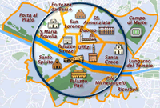Giotto
The Gothic painter who lay the groundwork for the Renaissance
Giotto di Bondone (c. 1267–1337) was a shepherd boy when he discovered by Cimabue, sketching his sheep on a rock.
Giotto would soon eclipse his master to become the greatest painter of the Gothic era, laying the artistic groundwork that would blossom into the Renaissance.
He was the first artist to give real weight to the people in his paintings—in the Byzantine era the preceded Giotto, everybody seemed to be floating in space. He gave people bulk to bodies under robes, he dressed saints in contemporary fashions, and he imbued the faces with character.
Instead of the staid Byzantine ranks of identical angels, Giotto painted unique angelic faces. Giotto painted lustily singing monks, tired-but-happy looking Virgin Marys, and saints and who wept openly at the death of Jesus.
In humanizing the art of painting, Giotto made it accessible to the throngs who crowded the churches on Sunday and stared up at his frescoes. In an era when Bible verses were intoned by priests in incomprehensible High Latin, Giotto made the stories of the Bible relatable, its characters into real human beings—divinely inspired perhaps, but still recognizable to the average peasant.
Art would never be the same.
Works by Giotto in Florence
- Santa Croce ★★ - The famous Bardi Chapel (Life of St. Francis); Preuzzi Chapel (Life of St. John the Baptist and Life St. John the Evangelist); Crucifix (1290/1300)and Virgin Mourning (1311/15) in the attached Museo dell'Opera di Santa Croce; also attributed to Giotto in Santa Croce is the Baroncelli Polyptych (1334), but this was likely to have been finished largely by Taddeo Gaddi and/or other assistants.
- Uffizi ★★★ - Ognissanti Maestà (1310); Badia Polyptych (1300-02)
- Campanile - Giotto was the first architect of the cathedral's belltower (1334); his original sketches and marble panels are now in the Museo dell'Opera del Duomo.
- Museo Horne - St. Stefano (1320/25)
- San Felice - Crucifix (1330s)
- San Giorgio alla Costa - Madonna and Child (1295/1300)
Related pages
- More notable Florentines
- Guided art and architecture walks and museum visits
- More top 10 lists
- Florence itineraries - What to do if you have 1 day, 2 days, or 3 days in Florence
- Florence FAQ
- Florence homepage
www.mediacult.com/art/giotto
ReidsItaly.com Florence Map
» View ENLARGED MAP with all listings
This article was written by Reid Bramblett and was last updated in April 2013. All information was accurate at the time.
about | contact | faq
» THE REIDSITALY.COM DIFFERENCE «
Copyright © 2008–2013 by Reid Bramblett. Author: Reid Bramblett















